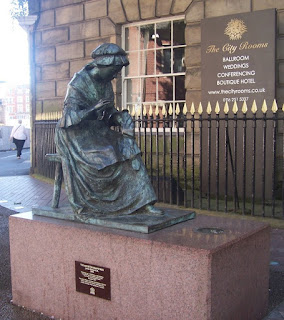The city of Leicester was to be our base for a week. In March I did an online course on England in the Fifteenth Century which coincided with the reinterment of the body of Richard III in Leicester Cathedral, therefore when the itinerary for the cricket tour was announced I was pleased to see that there would be time to explore part of this city.
We stayed at the Central Travelodge Hotel in Leicester which has an information board on the wall explaining that the hotel is built on the site of the Blue Boar Inn (originally the White Boar Inn) where Richard III stayed before riding off to the Battle of Bosworth. But Leicester is more than just Richard III and has more than 2,000 years of recorded history. This board is just one of the many information boards recording the city's extensive history.
We spent some time exploring the city and found a number of buildings and statues providing an insight into the Leicester of today as well as yesterday.
Sport is important in most large cities in Britain and Leicester is no exception. The Sporting Success statue commemorates the year 1996-1997 when Leicester had success in three sports - soccer, cricket and rugby.
The Haymarket Memorial Clock Tower is located at the junction of five streets in the centre of Leicester and the four figures depicted on the tower are of major benefactors to the city. The tower was completed in 1868. The figures are of Simon de Montford, William Wigston, Gabriel Newton and Thomas White.
The old Guildhall building (dating back to 1390) near the cathedral is another reminder of Leicester's past.
The High Cross is another reminder to the medieval history of the city. This is the last of eight similar pillars that would have had a dome shaped roof with the cross on top to signify that this was a market town. The market cross was constructed in 1577 and was partly demolished in 1773. This pillar had been located near Leicester Marker from 1977 but was relocated to its present position in the new Jubilee Square in 2014. There is a mark on the nearby footpath showing where the original structure once stood.
Leicester Market continues to be a busy part of life in Leicester.
There are a variety of stalls each day but the many fruit and vegetable stalls are particularly popular.
Walking in one of the side streets I found this Seamstress Statue, a monument to the hosiery industry once important in the area.
Another monument to Leicester's industrial past is illustrated in this sculpture near the river.
The River Soar plus canals flow through part of the city and are crossed by a series of bridges.
Leicester consists of many shopping precincts, perhaps the most modern one being Highcross, an illusion to the city's market past. A variety of shops, restaurants plus a cinema are located at Highcross.
By contrast also in this area is an older building, now a restaurant, dating back to 1573. The building was constructed as a school by Thomas Wigston. In later years the building was used as a carpet factory and later as a booking office for a transport company.
The home of the Wigston family was built in 1490 for Roger Wigston, a wool merchant and politician. Additions have been made to the home over the centuries.
This view from the hotel window shows a panorama of rooftops plus the spire of Leicester Cathedral. Each evening we could hear the peel of the bells from the cathedral.
The oldest church in the city is St Nicholas' Church originally built in Saxon times but remodelled many times since.


















Great photos Vicki
ReplyDelete